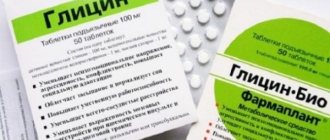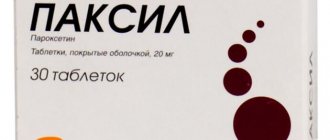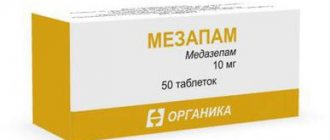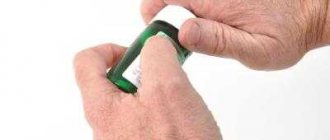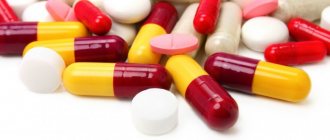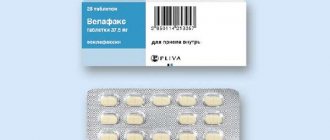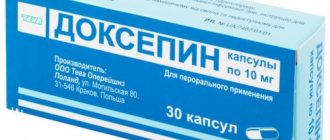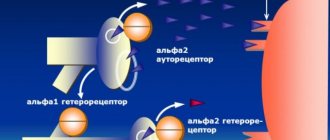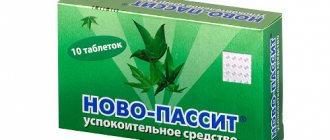Glycine is a nootropic drug that improves metabolic processes in the brain. Instructions for use will explain how to properly take 100 mg and 300 mg tablets. From the reviews you can find out whether this remedy helps in the treatment of encephalopathy, stroke, neuroses in children (including newborns) and adult patients.
What foods contain glycine?
Products that contain protein contain glycine. Protein contains:
- meat, fish products,
- liver;
- cottage cheese;
- eggs;
- gelatin-containing products: jelly, marmalade, jelly;
- legumes: soybeans, lentils, peas, chickpeas, beans;
- nuts:
- sunflower seeds
Pasta, bread, and cereals are rich in amino acids: buckwheat, oatmeal, pearl barley. A person should consume 4-7 g of useful amino acid per day. The human body is able to produce approximately 3 grams on its own, and receives about 2 g from food. The need to take amino acids increases if there is heavy physical or mental stress, injury, or cardiovascular problems.
Benefits of glycine
What are the benefits of glycine?
- Has an anti-inflammatory effect.
- Protects muscles from atrophy.
- Improves the functioning of the thymus gland.
- Positively affects the functioning of the brain and spleen.
- Stimulates metabolic processes, brain metabolism.
- Struggling with psycho-emotional stress.
- Turns on protective inhibition in the central nervous system.
- Basic enzymes in the body are formed faster.
- The drug glycine is needed for the production of blood cells.
The human central nervous system is the main part of the entire nervous system. It has two sections: the brain, the spinal cord. Parts of the brain monitor thinking, speech, and coordination. They are responsible for the sense organs providing vision, hearing, smell, touch, and sensation in space. The functions of the spinal cord include regulating the functioning of organs within the body, ensuring their coordinated interaction, and the motor ability of the body, controlled by the brain.
The autonomic nervous system is autonomous, constantly working and responsible for the viability of all organs and systems in the central nervous system. It consists of the sympathetic and parasympathetic divisions. The sympathetic department is in “attack mode,” while the parasympathetic department is in “rest mode.”
With the modern rhythm of life, stressful situations often arise that activate the sympathetic department. Because of this, concentration and mental performance decrease, memory deteriorates, sleep becomes restless - which is why a person does not rest.
The action of glycine - antitoxic, antioxidant, adrenergic blocking, neurotransmitter - is aimed at solving these problems. Being part of proteins, glycine, as a neurotransmitter, is responsible for inhibitory processes.
The beneficial properties of glycine help in the following cases:
- with psycho-emotional stress;
- when showing aggression;
- with increased conflict;
- with low social adaptation;
- in a bad mood;
- for depression;
- with restless sleep;
- with a decrease in mental performance;
- for vegetative-vascular disorders;
- with high blood pressure;
- with increased cravings for sweets.
Complex therapy includes taking amino acid tablets after strokes, traumatic brain injuries, alcohol, drug, and drug poisoning. The drug helps during menopause.
Stressful situations, mental and physical overload negatively affect the physiological production of a sufficient amount of aminoacetic acid by the nervous tissue. Therefore, taking the drug helps compensate for the insufficient amount of amino acid in the human body.
How much glycine can you drink per day (daily value)
The most popular regimen for using the drug is 1 or 2 tablets 2-3 times a day. If you have sleep disturbances, even 1 tablet will be useful. The daily dose depends on a number of factors, including the age of the patient and the type of disease. Taking 6 tablets (2 tablets after meals) is acceptable after traumatic brain injury or alcohol poisoning.
Advice! A person experiencing severe stress is allowed to take 2-4 tablets at a time; it will not cause harm.
Operating principle
As a side effect, the manufacturer only names the occurrence in rare cases of allergic reactions, which can manifest themselves in the form of redness of small areas of the skin, swelling, and itching.
Glycine Forte reduces the severity of the negative effects of neuroleptics, antidepressants, anxiolytics, sedatives, anticonvulsants and hypnotics. When used simultaneously with the above medications, the effect of inhibition of the central nervous system increases.
Glycine is always present in your body, even if you have never taken glycine, do not know what it is for, or even know what it is. Another name for the substance is aminoacetic acid. It belongs to the class of amino acids and is produced by the human body, being one of the 20 essential amino acids necessary for normal development and functioning. This amino acid has many important functions in the body, primarily in the nervous system.
The parasympathetic nervous system, which operates at rest, is responsible for many body functions. However, the activity of the sympathetic nervous system, which is activated under stress, is also important. Modern people are increasingly susceptible to stress - this is due to the rhythm of life - many of us are in a hurry, running, worrying about a variety of reasons. Such a life leads to stress, decreased concentration and mental performance, poor memory, and poor sleep.
Glycine is designed to solve these problems. It has the properties of a neurotransmitter and is part of the proteins responsible for inhibition processes in the nervous system. This amino acid also has alpha-adrenergic blocking, antioxidant and antitoxic effects. Glycine is also found in many foods, such as nuts and eggs.
What glycine can protect against:
- Psycho-emotional stress
- Aggressiveness
- Conflict
- Insufficient social adaptation
- Bad mood
- Bad dream
- Low mental performance
- Vegetovascular disorders
- Hypertension
- Sweet cravings
In addition, the medicine can be used as one of the means in complex therapy of diseases such as:
- Stroke
- Traumatic brain injuries
- Poisoning with alcohol and other substances that depress the central nervous system
It should be borne in mind that there is no scientific evidence of a serious effect of glycine when used as a means of improving mental performance in healthy people. And this is understandable, because since glycine is synthesized in the body, healthy nerve cells do not really need the extra amino acid.
Another thing is damage to the tissues of the nervous system when there is not enough substance in the body. The benefits of amino acids for various brain injuries are undeniable. In particular, glycine is important for children, especially infants, who have postpartum injuries that negatively affect the functioning of the nervous system. There are also studies showing improved sleep as a result of taking glycine preparations.
What is glycine for?
Before you start taking it, it is important to understand what any drug is needed for and what helps. Taking amino acid tablets is necessary in the following cases:
- manifestations of deviant behavior in children, when behavior deviating from generally accepted social rules becomes stable;
- hyperactivity of children, inability to concentrate, absent-mindedness;
- neuroses;
- depression, apathy;
- insomnia;
- decreased brain and physical performance;
- prolonged stress;
- vegetative-vascular dystonia;
- perinatal damage to the central nervous system;
- ischemic stroke;
- traumatic brain injuries;
- encephalopathy.
The drug is often prescribed to students during the session. Glycine tablets help with protracted conflicts and during adaptation to a new place. Taking the drug can alleviate oxygen starvation and help the body use oxygen more efficiently.
Glycine increases or decreases blood pressure
In order to understand whether the drug reduces blood pressure, how glycine and blood pressure are related, you need to understand the mechanism of the amino acid’s effect on the cardiovascular system. Having a mild sedative effect, the amino acid reduces the number of heart rhythms. Blood vessels dilate, blood flows to the internal organs. The pressure drops slightly. Therefore, regular intake of amino acid tablets protects against hypertensive crises. Important to remember:
- Tablets with amino acids can be used in the treatment of hypertension only as an additional remedy;
- by taking the drug you can achieve a short-term hypotensive effect;
- You should not use amino acid tablets for a long time as a means to lower blood pressure.
Glycine for the heart
Interruptions in the functioning of the central nervous system and an unstable mental state have a negative impact on the activity of the heart. Arrhythmia, increased blood pressure, swelling, insomnia, and disturbances in respiratory and heart rhythms may occur. The positive effect of the drug on the central nervous system avoids disruptions in the functioning of the heart and protects the arteries. Taking the drug helps prevent tachycardia, which occurs on the eve of sleep as a reaction to magnetic storms and stress. By restoring blood microcirculation, the amino acid improves well-being, redox processes proceed more gently, thereby reducing the impact on the body. The vascular muscles relax - this leads to normalization of the pulse.
Glycine for headaches
Headaches often occur due to increased stress, sleep disturbances, weather dependence, and vegetative-vascular dystonia. Ignoring these factors leads to migraines. My ears begin to ring, dark spots appear on my face, and severe pain rips through my head. All this is accompanied by nausea, vomiting, and drowsiness. Migraine attacks affect a person from one to two to ten times a month.
Having a mild sedative effect, amino acid tablets relieve headaches. Reducing anxiety and aggressiveness, improving mood, normalizing sleep and general psycho-emotional state. Glycine has a positive effect on the body as a whole, helping to avoid migraine attacks or alleviate their course.
Glycine Forte for children analogues glycine-forte.ru. How to use Glycine Forte correctly?
Instructions
Glycine Forte from Evalar is a dietary supplement with a high glycine content, which has a positive effect on the activity of the nervous system. Used for neuroses, stress, alcoholism (chronic) and other psycho-emotional disorders. Suitable for older children and adults.
Glycine Forte from Evalar is a dietary supplement with a high glycine content, which has a positive effect on the activity of the nervous system.
Latin name
The name of the drug is derived from the other Greek word glycys and Latin fortis. The first literally means “sweet”, due to the sweetish taste of the amino acid glycine. The second is translated as “powerful, strong.”
The Latin name of the dietary supplement is Glycine forte. The last word of the name emphasizes the enhanced composition of the drug.
We recommend reading - Hemorrhoids in women: symptoms.
Release forms and composition
The drug is available in the form of tablets that have a mild odor and a sweetish taste. The main active ingredient is glycine. Also contains vitamins b 12, B6, B1, necessary for:
- maintaining a healthy nervous system;
- optimization of mental activity;
- reducing irritability.
Auxiliary components of the drug:
- anti-caking agents (calcium stearate, silicon dioxide);
- cellulose;
- sorbitol;
- natural flavors.
The drug is available in the form of tablets that have a mild odor and a sweetish taste.
The product is available in packages of 20 or 60 tablets, each of which contains 500 or 300 mg of the active substance.
Sublingual tablets
The dietary supplement is sublingual. Like the classic drug Glycine, it is intended for resorption under the tongue. It has a sweet taste, which makes taking the tablets not only useful, but also pleasant.
Mechanism of action of the drug Glycine Forte
The active component of the drug is a non-essential amino acid that affects brain metabolism. Has an antidepressant and sedative effect. Positive effect on the central nervous system:
- reduces conflict and aggressiveness;
- improves mood and adaptation in society;
- makes it easier to fall asleep;
- increases mental abilities;
- reduces cerebral disorders.
As an adjuvant, the drug is effective in the treatment of epileptic seizures.
The drug Glycine is intended for resorption under the tongue.
Pharmacodynamics
The drug belongs to the group of nootropics. Positively affects metabolic processes in brain tissue. By regulating the activity of glutamate receptors, it reduces psycho-emotional stress and reduces the manifestation of vegetative-vascular disorders. Reduces the toxic effect of ethanol on the central nervous system.
Pharmacokinetics
The active substance easily penetrates the human brain, biological tissues and body fluids. It does not accumulate and is destroyed in the liver to carbon dioxide and water.
Why should you take Glycine Forte?
The main indication for taking a non-medicinal product is to reduce mental tension and stress. As part of complex therapy, it is used to treat the following conditions:
- stress;
- decreased or delayed mental development;
- deviant behavior;
- damage to the nervous system;
- emotional instability;
- neuroses;
- insomnia;
- alcoholism;
- headache associated with overwork;
- ischemic stroke.
The drug helps get rid of the consequences of traumatic brain injuries, encephalopathy, and binge drinking. Used as an aid in patients with diabetes.
The drug is also prescribed for preventive purposes: for increased mental activity, anxiety, depression, and sleep disorders.
Contraindications
Dietary supplements are prohibited for use by persons with hypersensitivity. It is unacceptable to use the product if you are intolerant to the components included in its composition: glycine, fructose, etc.
The drug is not prescribed for hemorrhagic stroke. Not used in pediatrics as its effectiveness and safety in children under 14 years of age have not been established. In patients suffering from arterial hypotension, glycine should be used with caution.
How to take Glycine Forte
The drug is taken in accordance with the regimen prescribed by a specialist. If there are no other recommendations, adhere to the dosage recommended by the manufacturer: 1 tablet 2 times a day. The duration of treatment is a month. If necessary, after a 10-day break, the course is repeated.
The drug is not prescribed for hemorrhagic stroke.
Before or after meals
The connection between meals and supplements has not been established, so the drug is taken at a convenient time. It is important that equal periods of time be maintained between taking the tablets, so it is recommended to dissolve them in the morning and evening.
You should not take dietary supplements with sweet or carbonated drinks, which slow down the absorption of the active component into the bloodstream and reduce the activity of the drug.
For adults
The recommended daily dosage of Glycine Forte for adults and adolescents (over 14 years old) is 600 mg. If necessary, it is increased. The tablets can be used sublingually (under the tongue) or buccally (dissolving behind the cheek).
Chemical composition and action
The chemical name for glycine is aminoacetic or aminoethanoic acid. This is a non-essential amino acid, meaning the body is capable of synthesizing glycine on its own.
Why is it needed:
- for the construction of a special red blood cell protein - heme, which then forms hemoglobin;
- is part of glycocholic acid, required for fat metabolism;
- removes poisonous benzoic acid, neutralizing it to harmless hippuric acid;
- participates in the synthesis of ATP, a compound that provides muscles with energy;
- reacts with receptors of the nervous system, causing mild inhibition of excess impulses.
Although our body is able to produce this substance, in some cases it is deficient. This is usually associated with increased glycine consumption, for example, in stressful situations, intense intellectual activity, alcohol abuse, and severe diseases of the nervous system.
Compound
The drug contains:
| Glycine |
|
| Thiamine |
|
| Pyridoxine |
|
| Cobalamin |
|
| Additional components |
|
Glycine forte Evalar composition
The drug does not contain:
- gluten;
- genetically modified by the body (GMO);
- components of animal origin;
- Sahara;
- artificial colors;
- flavorings.
Indications and contraindications
In pharmacology, the following properties of aminoacetic acid are used:
- the ability to regulate metabolism in the central nervous system;
- normalization of excitation and inhibition processes in the brain;
- stimulation of mental performance;
- fight against depression and irritability;
- normalization of sleep;
- ability to remove toxins from the central nervous system.
Strictly as prescribed by a neurologist, the drug is used to treat patients with epilepsy and people who have suffered a stroke. Doctors of other specialties prescribe the drug for neuroses and depression, consequences of traumatic brain injuries, encephalopathies, and alcoholism.
The drug has only one contraindication – hypersensitivity. For example, an excitation reaction instead of the expected inhibition or allergic reactions.
Contraindications and side effects
Glycine has almost no contraindications. It can be prescribed to infants, adults and the elderly. The drug is approved during pregnancy and lactation. The most serious contraindication is individual intolerance to the substances contained in the tablet.
Glycine also has few side effects. Rare side effects - lethargy, weakness, drowsiness, low blood pressure. Therefore, the drug should be taken with caution by people with arterial hypotension. No effect of the drug on concentration of attention and speed of psychomotor reactions was found.
Since glycine is a natural substance for the body, it does not accumulate in tissues, but is quickly broken down and excreted from the body. Among the interactions with other drugs, a weakening of the effect of neuroleptics, antidepressants, hypnotics and anticonvulsants should be noted. The drug is available in pharmacies without a prescription.
The drug should not be taken while pregnant, breastfeeding or during childhood. Glycine Forte is not prescribed for hypersensitivity to its components, fructose intolerance, hemorrhagic stroke, or sucrase deficiency. The drug is used with extreme caution for arterial hypertension.
No prescription is required to purchase a natural antidepressant, so anyone who wants to improve the overall tone of their body can take a course of the drug.
The amino acid is necessary to restore normal functioning of the nervous system.
The main pathological processes for the elimination of which the doctor prescribes a sedative:
- previous stroke, neurosis, atherosclerosis;
- consequences of traumatic brain injuries;
- hypertension; epilepsy; vegetative-vascular distance;
- childhood hyperactivity;
- chronic fatigue, insomnia;
- menopause, as well as the premenopausal period;
- excessive alcohol consumption causing intoxication.
As a sedative, glycine is recommended to be used in stressful situations (exam, job interview).
There are practically no contraindications for taking a sedative, except in cases of increased sensitivity of the body to any component. It is also recommended to take the amino acid with caution for hypotensive patients.
If hypersensitivity to glycine is detected in the patient, the course of treatment is canceled. Its use is also not recommended for arterial hypotension, as well as its combination with tranquilizers, sleeping pills and antipsychotic drugs.
Important! In a small percentage of cases, taking a drug to improve brain activity can cause allergic reactions.
Glycine and men's health
It would seem, why do adult men need glycine? After all, judging by the description, this is a drug for treating the nervous system.
This is true, but among the causes of weak potency or other erectile dysfunction and ejaculation, diseases of the nervous system come first. Even minor stress can affect this delicate process.
By relieving irritability, aggressiveness, and fatigue, glycine evens out the emotional state of adult men, which relieves psycho-emotional stress. The drug is needed in order to remove the simplest, underlying factor of sexual dysfunction.
It will not help if the cause is deeper, but, as a rule, male health disorders do not occur without a psychosomatic component. Any problems in the intimate sphere are extremely traumatic.
Therefore, a problem that arose, for example, due to inflammation, may continue to bother a person even when there are no physiological causes left. This means that nerves are getting in the way.
The danger of drugs such as glycine is that a person, counting on their effect, loses weeks and months. If the cause of impaired potency is not overwork, it may be a disease that cannot be cured with aminoacetic acid.
In this case, lost time will lead to a worsening of the situation, more severe and lengthy treatment and, possibly, a worse effect of therapy. Therefore, you can start the course only after tests have been taken and a conclusion from a urologist-andrologist has been received that no dangerous abnormalities have been found in the body.
If, after the examination, the doctor is inclined to believe that overwork led to erectile dysfunction, early ejaculation and other male difficulties, glycine is the drug of first choice. You should not expect an immediate effect from it; this is not Viagra or other similar drugs that act immediately after taking it.
The two most significant advantages of glycine in the fight against erectile dysfunction are its therapeutic effect (it does not eliminate the symptom, but fights the cause) and harmlessness in recommended doses.
Aminoacetic acid for athletes
Glycine is needed by an adult man during increased physical activity in order to maintain health and improve results. It is part of collagen, which maintains the elasticity of the ligamentous apparatus, and is involved in the biochemical reaction that saturates the muscles with energy. The mild calming effect of this amino acid is effective before competition.
Aminoacetic acid is also useful for drying. It helps break down fats and dulls the feeling of hunger, which means it makes it easier to tolerate the diet required in the period preceding sports competitions.
Dosages
Glycine is used sublingually or buccally - dissolving under the tongue or behind the cheek. It begins to be absorbed into the blood already in the oral cavity, but there is no point in swallowing tablets - the aggressive environment of the stomach contents will simply digest the delicate molecule.
The usual dosage is 1 tablet of 100 mg 2-3 times a day for 14-30 days. For athletes, the method of administration is slightly different: 4 tablets, the last of which is taken before bed.
Glycine does not accumulate in the body, so it is difficult to overdose on it. The effect of using high doses of the drug has been little studied, but symptoms of excessive use included increased blood pressure, increased heart rate, weakness, loss of consciousness, and nausea.
The lethal dose of the substance has not been precisely established and is highly individual. Glycine enhances the effect of most sedatives. Therefore, they cannot be combined without a doctor’s prescription.
Despite the fact that glycine is in principle compatible with ethanol, the effect on potency when combining this medicine with alcohol can be the opposite: too much relaxation. This reaction is individual; for many, the medicine, on the contrary, helps overcome the toxic effect of alcoholic beverages.
Application
Glycine Forte Evalar (reviews published on the Internet suggest using the drug to increase brain activity, the need for which arises with increased mental stress) is prescribed as needed:
For adults
Persons over 18 years of age should take 1 dietary supplement. 2 per day. The tablet should be placed under the tongue and dissolved until completely dissolved.
This is interesting: Urinalysis. Decoding for adults, norm, designations, what indicators mean
In case of deterioration of the condition or activation of autonomic disorders, Glycine Forte is prescribed 2 tablets. 3 times a day simultaneously with other drugs that increase cerebral circulation.
The course of treatment with tablets is at least 1 month, and, if necessary, can be continued after a 10-day break.
You should not increase the dosage on your own.
For the elderly
Persons over 65 years of age are allowed to take Glycine-Forte in the usual dosage, 2 tablets, dissolved until completely dissolved, 3 tablets per day for 30 days.
For pregnant
The nutritional supplement is contraindicated for women expecting a baby and young mothers breastfeeding, due to the risk of provoking negative consequences that are dangerous to the health of the woman and her baby.
For children under 18 years old
Glycine-Forte is usually not prescribed for preschoolers and adolescents under 18 years of age, but if necessary, the drug may be prescribed from the age of 14-16 years.
Dietary supplement taken by adolescents:
- if it is necessary to correct deviant behavior;
- when increasing mental activity and preventing nerve blockage during exams;
- to protect and quickly relieve the negative effects of stress;
- as a drug that improves cerebral circulation in the development of vegetative-vascular dystonia;
- for injuries and swelling of the brain and encephalopathy.
Glycine forte Evalar
Minors are prescribed the usual dosage of 1 tablet, to be dissolved until completely dissolved, 2 tablets per day. The drug may only be taken under the supervision of a pediatrician. The duration of treatment is determined by the doctor individually.
Description, composition and release form of the drug
Description, composition and release form of the drug
Description: white tablet with a chamfer and a score on both sides. Marbling and inclusions from yellow to dark burgundy are allowed.
Ingredients: glycine, povidone, magnesium stearate, microcrystalline cellulose.
Release form: small, flat cylindrical tablets weighing 100 mg.
Glycine is a metabolic drug, that is, its action is aimed at improving metabolic processes in the body. It restores neural connections and activates inhibition processes in the central nervous system , relieves excessive psycho-emotional stress, improves mood, normalizes sleep, reduces the severity of organic disorders after traumatic brain injury and much more.
Pharmacodynamics and pharmacokinetics
The amino acid in the drug attaches a mediator (glycine) to brain receptors that provoke inhibition of nerve cells. The result is sedative and anti-stress effects. Under the influence of the medicine, performance increases, sleep patterns are normalized, mood improves, and conflict and aggressiveness decreases. The drug blocks the release of stress hormones - adrenaline and norepinephrine. B vitamins also have a positive effect on the body:
- B1 – normalizes the state of the nervous system, stimulates the thinking process and mental performance;
- B6 – improves brain functioning, helps overcome irritability;
- B12 – accelerates the renewal of the structure of nervous tissue, increases concentration, improves memory.
This describes the pharmacodynamics of the drug. Pharmacokinetics reflects the path of the active substance in the body. When resorbed, the tablet is quickly absorbed, after which it easily enters the body tissues, including the brain and biological fluids. The substance does not accumulate, but is metabolized almost completely by the liver to carbon dioxide and water.
Indications for use
Indications for use
- memory loss;
- emotional tension and stress;
- behavioral deviations in children;
- high sports loads;
- various diseases of the nervous system, characterized by increased excitability, sleep disturbances, mood swings, sudden outbursts of emotions, nervous conditions;
- concussions;
- ischemic stroke;
- vegetative-vascular dystonia (VSD).
Overdose - what to do?
If the dosage is exceeded, there is a risk of overdose. The main manifestations of intoxication of the body:
- dizziness;
- nausea;
- gagging;
- allergy;
- apathy;
- stool disorder;
- stomach ache;
- numbness of the limbs.
Overdose leads to the following diseases and conditions:
- arterial hypotension;
- diseases of the nervous system;
- sleep disorders;
- decrease in general tone.
A fatal outcome when taking tablets is possible with a single use of 20 g of the drug. Treatment of overdose involves rinsing the stomach with large quantities of water if the medicine has been taken recently.
How to use?
Children and infants
For mentally healthy children during times of severe stress and tension, with decreased memory and brain performance, as well as with deviant forms of behavior, etc. Prescribe 1 tablet 2-3 times a day for 2-4 weeks .
For disorders of the nervous system that are accompanied by increased excitability, sleep disturbances, and mental disorders, children under 3 years of age are prescribed half a tablet (50 mg) 2-3 times a day for 1-2 weeks. Then the number of doses is reduced to 1 time per day. This dose is taken at 50 mg for 10 days.
Children over 3 years old are prescribed 1 tablet 2-3 times a day , the course of treatment lasts 7-14 days. If necessary, it is increased to 30 days.
If a child has regular sleep disturbances, glycine is prescribed 0.5–1 tablet before bedtime, depending on age.
This drug is given to young children especially carefully, in accordance with the dose prescribed by the doctor, because it is much more difficult for them to bear the consequences of an overdose than for adults.
Glycine for babies
The drug is prescribed to an infant in the following cases: identification of birth trauma, overexcitation, sleep disturbance.
Due to the fact that independent resorption of the tablet form by infants is not possible, half the tablet must be crushed to obtain a powdery mass, then dissolved in water at room temperature. Dissolution does not affect the properties. In this case, the duration of treatment can be up to 4 weeks - this will allow you to evaluate the beneficial effect. Possible harm is assessed by the attending physician: as a rule, it is unlikely, and the potential benefits are much higher than the risks.
For adults
Mentally healthy adults with emotional tension, stress, and sleep disorders are usually prescribed 1 tablet 3-4 times a day before or during meals, as well as 20 minutes before bedtime.
For ischemic stroke, adults are immediately prescribed 1000 mg of the drug with water, then 1000 mg/day for 1–6 days, then 1–2 tablets 3 times for the next 30 days.
How to drink glycine for adults
The benefits of glycine for the adult body are known.
In case of traumatic brain injuries and ischemic strokes, it is advisable to start taking the neurotransmitter immediately, even before the manifestations of the disease disappear. The recommended useful dose for ischemic stroke is 10 tablets within 3-6 hours after the first manifestation of symptoms of the disease. The first five days after a stroke you should take 10 tablets, then 3 a day for a month.
For insomnia, the drug is taken half an hour before bedtime or immediately before bedtime.
For chronic alcoholism or drug addiction, take 2-3 tablets. per day for 4 weeks.
Cardiologists have also proven the value of aminoacetic acid. For the prevention of heart pathologies, the benefits of glycine are unconditional: it is dissolved in 1 tablet. in a day.
Important! To prevent ischemic strokes, myocardial infarction and a number of acute heart diseases, doctors prescribe the blood thinning drug cardiomagnyl or aspirin cardio in combination with glycine, which in turn evens out arrhythmia and, together with the symbiosis of drugs, improves heart function.
Benefits for men and women
Medical practice has proven the usefulness of Glycine as an adjuvant for lowering blood pressure. The small effect of treatment is explained by the sedative effect of the amino acid, which can lower the pulse and dilate blood vessels, which results in a rush of blood to the internal organs. However, Glycine tablets are not taken uncontrolled; the frequency of administration depends on the severity of the disturbing symptoms:
- to improve memory, normalize mental state, and relieve nervous tension, adults are prescribed amino acid 2-3 times a day for a month;
- in order to get rid of insomnia, the instructions recommend that an adult patient take one Glycine pill before bedtime (20-30 minutes), the course of treatment lasts 2-3 weeks;
- To prevent the onset of binge drinking, alcoholics should take pills 2-3 times a day for a month.
Due to the ability of the amino acid to restore blood flow in the brain, taking Glycine is relevant for relieving acute stroke. The medicine in the amount of 4 tablets is started to be taken within the first 3-6 hours after an ischemic attack. Then take an identical dose for 5 days, dividing it into two separate doses. The dosage for the next month of use is 1 pill 3 times a day.
use of the drug
Pregnant
Since no connection has yet been found with glycine harming pregnancy or fetal development in any way, doctors still prescribe it.
You cannot start taking a course of these pills without the recommendations of your attending physician, because there are still contraindications.
This amino acid can cause an allergic reaction, which is extremely undesirable for pregnancy and fetal development.
But there are situations when doctors themselves prescribe glycine to calm and relax the expectant mother, relieve symptoms of fatigue and overexcitability.
The selection of an adequate dosage during pregnancy is individual in each case, but usually women are prescribed 1 tablet three times a day.
For athletes
As mentioned above, glycine has a beneficial effect on the body of athletes, increases the amount of amino acids in their body, and serves as an additional energy supplement. He helps:
- increase muscle mass and endurance by improving protein metabolism;
- increase brain activity by accelerating internal processes;
- calm down before difficult competitions;
- improve mood.
The dosage for athletes is no different from the dosage for adults. They need to take 4 tablets per day, 3-4 times before or after meals, after training, and before going to bed. Standard course - 4 weeks. After a certain break it can be repeated.
Athletes are the group of people who most often face the consequences of overdosing on various supplements due to their excessive desire to gain more weight and the necessary strength. Because of this, many of them experience protein poisoning. There is no need to drink handfuls of tablets to achieve the desired result; it is better to take glycine to avoid negative consequences.
Reviews about the use of the drug
Patients say the following about using the drug.
After changing jobs, I began to experience sudden panic attacks and anxiety. The increase in the total volume of tasks performed and growing responsibility had an impact. On the advice of friends, I immediately decided to opt for Glycine Forte.
Thanks to its pleasant taste and the ability to quietly experience the effect of the drug when it dissolves under the tongue during stress, I actively used it during important meetings and presentations. In addition to the quick effect of calm and confidence at the time of taking it, the drug also normalized my sleep during the week and created an overall positive mood, motivating me to work and meet new people.
With the arrival of autumn, the blues usually attack me. This year, the general state of weakness has also been supplemented by such alarming symptoms as the inability to concentrate on work. I began to forget the dates of important meetings and reports. Because of this, conflicts began both with colleagues at work and with members of the family.
Keeping a diary with notes did not help, as I simply forgot to look at it. When the problem reached alarming proportions, a work colleague advised me to try taking Glycine Forte for memory. I had not taken any such drugs before and was rather skeptical. To my surprise, the very next day after the appointment my attention began to focus on specific tasks.
My apathy disappeared and my mood improved. I now keep a diary regularly and look at it constantly.
It is more convenient for me to use forte, since the dosage is larger. Excellent for relieving nervous tension and restoring sleep.
The doctor prescribed glycine to me as an aid in the treatment of heart problems. The course of treatment helped improve brain activity. I also noticed that the reaction has improved.
I took it during sessions and helped quite well.
My second grade son's grades have declined due to inattention. The neurologist prescribed glycine. After the course of treatment, my son became more focused, more attentive, and by the end of the school year his grades improved.
What is glycine?
Essential amino acid Glycine (glycocol, aminoacetic or aminoethanoic acid) belongs to monoaminomonocarboxylic acids. Glycine is the first amino acid isolated from protein hydrolysates in 1820 by Braconnot. The molecular weight of the substance is 75.07 g/mol. The simplest aliphatic amino acid acquired its name because of its sweetish taste; the substance itself is colorless crystals. The daily requirement of the human body for glycine is 3 grams.
Operating principle and properties
Glycine is classified as a neuroactive acid that acts as a mediator of presynaptic inhibition of spinal reflexes at the suprasegmental and segmental level. The amino acid has significant neurotropic activity, affecting the neurogenic mechanisms of regulation of vascular tone.
The mediator role of glycine in different parts of the central nervous system is the synoptic inhibition of efferent pathways at the appropriate levels. Due to the neurotropic effect on the central structures regulating vascular tone, with the help of amino acids it is possible to favorably influence autonomic reactions and motor functions. In medicine, the biotic is used as a nootropic drug.
From the detailed instructions for glycine you can learn about the indications, contraindications, features of administration and other important characteristics of the biotic.
Release form, composition, packaging
Glycine tablets are white in color and are available in the form of flat-cylindrical capsules with a bevel. One tablet contains the active ingredient microencapsulated glycine - 100 mg and auxiliary components: water-soluble methylcellulose - 1 mg, magnesium stearate - 1 mg. Contour cell blisters (10, 50 pieces) are packaged in cardboard packages.
pharmachologic effect
Glycine tablets improve brain metabolic processes. The amino acid regulates metabolism, normalizes, and activates protective inhibition processes in the central nervous system. The substance has alpha-adrenergic blocking, glycine- and GABA-ergic, antitoxic, antioxidant effects.
Glycine regulates the interaction of glutamate receptors (NMDA), due to which the drug:
- reduces psycho-emotional stress, conflict, aggressiveness;
- improves social adaptation;
- lifts the mood;
- increases mental performance;
- facilitates the process of falling asleep, normalizes the correct alternation of physiological phases and the duration of sleep;
- eliminates unpleasant manifestations of vegetative-vascular disorders;
- reduces the toxic effects of alcohol and other drugs or medications that depress the functioning of the central nervous system.
- reduces the severity of cerebral abnormalities in ischemic stroke or traumatic brain injury.
Directions for use and doses
How to take glycine? Instructions for use in adults differ in the dosage regimen. Depending on the pathological condition, the dosage is reduced or increased. If the drug was prescribed at the clinic, then use it according to the prescription. When glycine is purchased independently, the use depends on age, gender, health, desired result and other factors.
Glycine forte evalar is an enhanced formula of the standard drug. The drug containing the essential amino acid is usually placed under the tongue and the tablet is dissolved for several minutes. From the sublingual area, the amino acid easily and quickly penetrates the bloodstream and spreads throughout the tissues and biological fluids of the body. The substance penetrates the brain structures most quickly. During the process of biotransformation, the amino acid is split into water and carbon dioxide; it does not accumulate in the body.
For psycho-emotional stress, decreased memory, attention or mental performance, deviant forms of behavior, mental retardation, glycine tablets are indicated for adults in a dosage of 1 tablet 2-3 per day for 14-30 days.
For functional and organic lesions of the central nervous system, which are accompanied by excessive emotional lability and excitability, as well as sleep disturbances, glycine is prescribed to adults in a dose of 1-2 tablets 2-3 times a day. The course of treatment is 7–14 days; if it is necessary to enhance the therapeutic effect, the dose is increased.
For patients with brain disorders due to ischemic stroke, glycine tablets are prescribed to adults at a dose of 1000 mg during the first 3–5 hours after the attack. Take the medicine buccally or sublingually with one teaspoon of water. In the next 2–5 days, the drug is taken at a dose of 1000 mg/day. The course of treatment is continued for a month, but after the first five days, tablets are taken 1-2 tablets 3 times a day.
If you have difficulty falling asleep, glycine tablets should be taken 20-30 minutes before going to bed, 1 or 2 pieces. In patients with alcohol or drug addiction, the drug is needed to reduce psycho-emotional stress in case of organic lesions of the peripheral and central nervous system. The medicine is taken 1 tablet 2-4 times a day for about 30 days. It is advisable to repeat biotic therapy 4-5 courses per year.
Which is better - Glycine or Glycine Forte
Glycine is available in tablet form. Recommended method of use is dissolution under the tongue. Glycine has a sweetish taste (hence its name - “glycis” means “sweet” in Greek), and therefore children take it with pleasure. There is no need to take the tablet with water. The effectiveness of glycine does not depend on food intake. The shelf life when stored at a temperature not exceeding 25 ºС is 3 years.
Compound
The composition of the drug, in addition to the amino acid itself, includes excipients: 1 mg of methylcellulose, 1 mg of magnesium stearate. The mass of the active substance is 100 mg.
Glycine preparations are also produced, which contain B vitamins - B1, B6 and B12, as well as tablets with a different dosage.
The drug activates the functioning of brain cells, relieves stress, and improves mood. As a result, efficiency increases and the sleep process is normalized.
Features of application:
- is not an antibiotic;
- taken regardless of food intake;
- the course of treatment is designed for one month of use;
- calms the nervous system during the menstrual period, therefore it is indicated for menstruation;
- for HIV, the drug has no contraindications and can be taken as usual;
- can be combined with antibiotics without contraindications;
- goes well with alcohol, glycine protects the brain from the harmful effects of ethanol;
- You can take it while driving a car, as the medicine calms you but does not cause lethargy;
- the sedative effect of glycine causes a decrease in blood pressure.
Glycine is an over-the-counter drug.
The active substance of the drug is glycine. Additional components: magnesium stearate, povidone, microcrystalline cellulose. The drug has antidepressant and sedative properties, improves metabolic processes in brain tissue. The tablets reduce aggressiveness, emotional stress, and the severity of vegetative-vascular pathologies.
Glycine Forte is prescribed for sleep disorders, problems with social adjustment, and mood swings. The medicine increases mental performance. Used in combination therapy for epileptic seizures.
When wondering which remedy is better, you should pay attention to the composition of the drugs. Forte, in addition to amino acids, contains B vitamins, each of which plays a role in the normal functioning of the nervous system.
| Compound | Standard drug | dietary supplement |
| Amino acid (mg) | 100 | 300 |
| Vitamin B1 (mg) | – | 5 |
| Vitamin B6 (mg) | – | 6 |
| Vitamin B12 (mg) | – | 0,009 |
Deficiency of vitamins B1, B6, B12 leads to decreased attention, emotional depression, and fatigue. The vitamin complex stimulates brain activity, improves memory, and gives energy.
However, this does not mean that you always need to replace the standard drug with its analogue. Ordinary Glycine performs its tasks well, and its price is much lower than that of dietary supplements.
Glycine: benefits and harms, instructions for use for children and adults, reviews
Glycine, an organic compound with the formula NH2CH2COOH, belongs to the group of neurotransmitters, and the benefits and harms of glycine depend primarily on compliance with the rules for its use.
This substance can be obtained externally from foods high in protein (eggs, meat, nuts, cottage cheese), as well as by taking a pharmacological drug of the same name.
Aminoacetic acid, which is the chemical name of the compound, has become very popular due to its many beneficial properties.
Useful properties of glycine
The product has a number of useful properties:
- reduces aggressiveness;
- normalizes sleep;
- improves memory;
- reduces disorders resulting from a heart attack or stroke;
- alleviates the condition of intoxication;
- improves performance.
The benefits of glycine as a medicine for the prevention of various diseases are undoubted.
- Taking glycine helps lower blood pressure levels, which is one of its most outstanding properties.
- The benefit of glycine also consists in reducing vegetative-vascular manifestations, including during menopause.
- Interestingly, glycine is a popular recovery aid for athletes between workouts.
- Glycine has been noted to be beneficial as a means to improve metabolism in the brain.
Important! A positive effect from taking it is observed only when pathological changes are diagnosed. The benefits of glycine for a healthy person’s body are determined individually in each case.
Benefits of glycine for men
The product has become quite widespread due to its effectiveness in eliminating problems caused by sexual dysfunction in men.
Prescribed by the attending physician if it is determined that potency problems are associated with a psychological disorder or trauma.
The benefit lies in removing toxins from the body, relieving psychological stress before sexual intercourse, and strengthening the walls of blood vessels.
To increase potency, glycine must be taken in full for the beneficial effect to be maximum.
Attention! This medication is not a treatment for impotence and is not intended to completely eliminate all sexual problems in men.
Can pregnant women take glycine?
During pregnancy, the drug shows itself well as a sedative. It is prescribed in any trimester, as it does not harm the fetus.
The benefits of glycine for pregnant women include creating favorable conditions for fetal development and reducing the risk of neurological pathology in the child. Regular use is beneficial for the normal course of pregnancy until childbirth.
Is glycine good for breastfeeding?
During breastfeeding, aminoacetic acid, due to its beneficial properties, has a positive effect on the processes occurring in the body of a nursing mother. Metabolism is normalized, cognitive processes are improved, and there is also benefit in regulating the rhythms of sleep and rest.
It is recommended to coordinate the treatment course with your doctor. Pediatricians prescribe glycine to children under 1 year of age and nursing mothers. This is explained by the absence of proven harm to the body of the mother and child, its production from plant materials and only a small amount entering colostrum and breast milk.
Glycine Forte for children 8 years old. Rules of application
"Glycine" for children can be recommended by a neurologist or pediatrician. The drug has its own indications, and the frequency of administration and duration of treatment depend on the diagnosis.
If the baby has diseases of the nervous system, manifested by problems with sleep, hyperactivity or excessive agitation, then patients under 3 years of age are prescribed 50 milligrams of glycine 2-3 times a day. The course lasts a week or 10 days. Then the frequency is reduced to once a day and the tablets are taken for another 10 days.
When the baby is already 3 years old, he is prescribed 100 milligrams of glycine at a time. Take 2-3 times a day for one to two weeks. The doctor may recommend continuing treatment for up to a month if indicated.
If a child has memory impairment, mental retardation, tension or decreased mental activity, the drug is prescribed 2-3 times a day, 100 milligrams for children over 3 years of age. Treatment lasts from two weeks to a month.
When the baby only has insomnia or difficulty falling asleep, the doctor may also prescribe the drug. In this case, the tablets are taken 20-30 minutes before going to bed. Age determines how much glycine to offer. For children under one year of age, the dosage is 50 milligrams. You can increase to 100 milligrams only after 3 years.
Of course, parents of children often expect an immediate effect from the prescribed treatment. However, it is difficult to predict when the results of therapy will be noticeable. It has been proven that the effect of glycine completely depends on the individual reaction of the body and its specifics.
Consequences of glycine overdose
Despite the non-toxicity of glycine and the ability to be excreted naturally, its abuse can lead to some harm. Most often, such cases occur with children who are attracted by the sweet taste of aminoacetic acid.
With an overdose of glycine (more than 3 g per day), an increase in its sedative properties is observed.
Symptoms:
- dizziness;
- nausea;
- general weakness;
- drowsiness;
- blood pressure decreases.
If you have hypersensitivity or a predisposition to allergies, redness of the skin, eyes, runny nose, and diarrhea may occur.
Attention! If these signs appear, it is necessary to immediately stop taking the drug, drink plenty of fluids and consult a doctor.
Is glycine compatible with alcohol?
Taking glycine helps speed up metabolism and eliminate toxins formed under the influence of ethyl alcohol. The neurotransmitter is used both in chronic alcoholism and in the severe consequences of binge drinking as an adjuvant, as well as to eliminate hangover syndrome. A beneficial effect is observed after dissolving two tablets. A maximum of 4 such doses are allowed per day.
Warning! An overdose of neurotransmitters when drinking alcoholic beverages is harmful, as it increases intoxication.
special instructions
A nutritional supplement is prescribed only after consultation with a specialist. The components contained in the dietary supplement are of natural origin, are found in almost all tissues and fluids of the body and are not addictive.
You should not combine the use of Glycine Forte with alcoholic beverages, since one of the qualities of the dietary supplement is to reduce the negative side effects of alcohol and reduce the craving for drinking alcohol.
Glycine analogues
Glycine has analogues with similar beneficial effects and properties. They contain other active ingredients, but the principle of their action is generally the same.
The most popular neurotransmitter analogs:
- Mexidol. Used to improve brain function and is effective in combating withdrawal symptoms.
- Tryptophan. Recognized as useful in the treatment of depressive disorders, reduces the harm and severity of alcohol withdrawal.
- Neurotropin. Used for dyscirculatory encephalopathy, its benefits for reducing anxiety levels have been proven.
The benefits and harms of each of the above-mentioned analogs should be assessed solely on an individual basis, taking into account the diagnosis, the degree of disorders, concomitant pathologies, as well as the properties of other medications taken.
How to stabilize potency?
To eliminate sexual impotence caused by psycho-emotional disorders, an adult man is prescribed to drink Glycine one tablet 2-3 times a day. Treatment with a sedative leads to a decrease in the increased excitability of the cellular structures of the brain due to increased blood flow through dilated vessels. How exactly the treatment will affect male potency:
- metabolic processes are normalized against the background of increased blood circulation;
- erection will increase due to increased elasticity of the tissues of the penis;
- your mood will improve due to a decrease in mental stress;
- The concentration of alcohol and other toxic substances in the blood will decrease.
Treatment with the drug, which does not require a prescription, relieves an adult man of alarm signals while waiting for a full erection. Representatives of the stronger sex, who have previously experienced erectile dysfunction, gain confidence in their own masculine strength. To obtain a lasting effect of therapy, the instructions for the product warn about the inadmissibility of combining Glycine with antipsychotic and anticonvulsant medications, or sleeping pills.
Analogs
Tenoten is used in cases of brain dysfunction and neurological pathologies. Stabilizes emotions and fights depression. It does not have a proven base of consequences of use, therefore it is rarely recommended by doctors.
Biotredin is mainly used to relieve hangover syndrome. Affects brain cells, improves thought processes, memory, attention. However, it has a narrower scope of application and does not affect metabolic processes, unlike glycine.
Afobazole reduces the activity of nervous processes and fights alcohol and nicotine addiction. Prohibited during pregnancy, unlike Glycine Forte.
Piracetam increases blood circulation in the capillaries of the brain. It has a positive effect on the flow of thought processes and strengthens memory. Does not affect mental disorders and depression, unlike Glycine Forte.
The list can also be continued by including Glycine-Canon; Glycine-ozone; Phezam; Phenibut; Glycised; Pyracesin; Acefen; Nooclerin. But the triple action of Glycine Forte makes this dietary supplement stand out from the list of drugs. We can highlight the greater versatility of Glycine Forte for memory and a wider range of problems it solves due to the presence in its composition of the daily norm of B vitamins. The drug is safe and can be taken at any age without causing addiction.
Glycine also has analogues, but it is still the same drug with different names - Glycine Forte Evalar (300 and 600 mg tablets), Glycine-Canon (1000 mg tablets), Glycine-Bio, Glycine Active, Glycine-Vis (capsules 300 mg). Glycine Forte Evalar and Glycine-Vis also contain B vitamins, which are designed to enhance the beneficial effect of the amino acid on nervous activity. In addition, these products, like Glycine Active, are not medicines, but dietary supplements.
Indirect analogs of glycine can also include other nootropic drugs, such as tryptophan, phenotropil, piracetam, glutamic acid, mexidol, etc. However, their mechanism of action is somewhat different and in most cases they will not be able to replace glycine.

